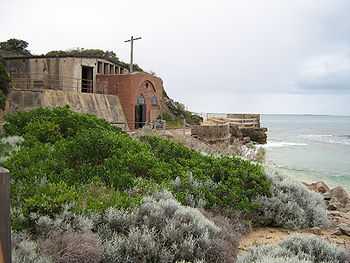Point Nepean


Point Nepean marks the southern point of The Rip (the entrance to Port Phillip) and the most westerly point of the Mornington Peninsula, in Victoria, Australia. It was named in 1802 after the British politician and colonial administrator Sir Evan Nepean by John Murray in HMS Lady Nelson.[1] It is within the suburb of Portsea. Its coast and adjacent waters are included in the Port Phillip Heads Marine National Park, while its land area is part of the Point Nepean National Park. Cheviot Beach is located on Point Nepean, where the SS Cheviot was wrecked in 1887 and Prime Minister of Australia, Harold Holt, disappeared on 17 December 1967, presumed drowned.
History
Evidence of Australian Aboriginal settlement of the area dates back 40,000 years. Point Nepean was a birthing place for women of the Boonerwrung People.[2] There are 70 registered Aboriginal archaeological sites within the Point Nepean National Park.[3]
Limestone was mined from the coastal cliffs from the early days of European settlement and two lime kilns were built around 1840. Point Nepean Quarantine Station was opened in 1852 and is the second oldest intact quarantine station in Australia. It contains the oldest buildings erected for quarantine purposes in Australia, four of the main hospital buildings (established in 1857), pre-dating the oldest intact quarantine-related structures at North Head, Sydney, by sixteen years. The Quarantine Station operated until 1980.
Point Nepean Post Office opened on 1 April 1859 but was closed by 1865.[4] Fortifications were built from 1878. Gun batteries were installed at Fort Nepean in 1886 and Eagles Nest in 1888. A gun battery was constructed at Fort Pearce in 1911. With the removal of coastal artillery after World War II, the facilities housed an Officer Cadet School and the School of Army Health from 1951 to 1985.
Land sales
Parts of Point Nepean were declared national park in 1988. The Commonwealth government offered to sell the land to the state of Victoria in 1998 and again in 2001, but the state rejected the offer.
In 2002 the Department of Defence proposed selling 311 hectares of land for development, retaining 1.6 hectares which contains contaminated soil and unexploded ordnance. The proposed sale was abandoned in 2003 following strong community protest. In 2004, 90 hectares of Defence land was transferred to the Commonwealth government's Point Nepean Community Trust, which managed the former Quarantine Station until the land was transferred to the Victorian government on 8 June 2009. The Commonwealth also transferred 205 hectares of bushland (former Firing Range area) to Parks Victoria and the remaining 17.6 hecatres to the Shire of Mornington Peninsula for community use.
The former Quarantine Station was opened to the community as part of Point Nepean National Park in December 2009.
Military ruins

Fortifications were built on land from 1878 onwards. Gun batteries were installed at Fort Nepean in 1886 and Eagles Nest in 1888. Barracks were constructed at Fort Pearce. With the removal of coastal artillery after World War II, the facilities housed an Officer Cadet School and the School of Army Health from 1951 to 1985. Some of the historic features include (major features shown in bold):
- Gun Junction — gun barrel ruins and guard house
- Norris Barracks — incorporates buildings from the former Quarantine Station
- 25m rifle range
- Cattle Jetty Ruins (1879) – Observatory Point
- Point Nepean Cemetery (1854–1952)
- Cheviot Hill
- WW2 gun emplacement, battery and observation post
- Machine Gun Emplacement
- Eagles Nest
- Fort Pearce
- Pearce Barracks
- Gun Emplacements
- Historical retaining wall
- 8 Gun Emplacements
- Engine House
- Historic Gun Barrels
- Underground Tunnels
Environment
The coast of Point Nepean contains intertidal reef platforms with high invertebrate diversity as well as subtidal reefs with diverse communities of fish, invertebrates and encrusting organisms such as ascidians, sponges and bryozoans.
References
- ↑ Flinders, Matthew (1814), A Voyage to Terra Australis, Vol 1, London: G. and W. Nicol, p. 212, entry for 27 April 1802
- ↑ "Portsea's point of contention". The Age. 2003-12-13.
- ↑ "People power wins out at Point Nepean". The Age. 2003-08-26.
- ↑ Premier Postal History. "Post Office List". Retrieved 2008-04-11
- Parks Victoria. (2006). Port Phillip Heads Marine National Park Management Plan. Parks Victoria: Melbourne. ISBN 0-7311-8349-5
External links
| Wikimedia Commons has media related to Point Nepean. |
- Point Nepean National Park Parks Victoria
Coordinates: 38°18′07″S 144°39′07″E / 38.302°S 144.652°E